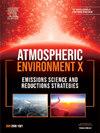A multiscale geographically weighted regression approach to emphasize the effects of traffic characteristics on vehicular emissions
IF 3.8
Q2 ENVIRONMENTAL SCIENCES
引用次数: 0
Abstract
The rapid growth in motor vehicle numbers over the years has notably increased air pollution levels, particularly in developing countries. According to the International Energy Agency, road transport significantly contributes to air pollution more than other transportation. This study aims to investigate the spatial distribution impact of various built environment, sociodemographic, meteorological, and traffic-related features across buffer distances on vehicular emissions from all vehicle types at the link level. Initially, this study restructured data to perform 25 combination models for five emissions from all vehicles, classified into five types. Secondly, regression models were created using Ordinary Least Squares (OLS) and Multiscale Geographically Weighted Regression (MGWR) in ArcGIS Pro, assessing the spatial impact of these features on emissions for each road segment in North Carolina in 2019. Model performance was evaluated using adjusted R-squared and R-squared metrics, with the MGWR model outperforming the OLS model, achieving adjusted R-squared values between 74% and 97%. Finally, it analyzes the spatial distribution impact of each feature on each emission from vehicle types at the link level. Particularly, the significant impact of traffic-related features on vehicular emission offers valuable insights for governments and decision-makers to develop targeted transportation planning strategies and meet air pollution targets set by the state.
求助全文
约1分钟内获得全文
求助全文
来源期刊

Atmospheric Environment: X
Environmental Science-Environmental Science (all)
CiteScore
8.00
自引率
0.00%
发文量
47
审稿时长
12 weeks
 求助内容:
求助内容: 应助结果提醒方式:
应助结果提醒方式:


